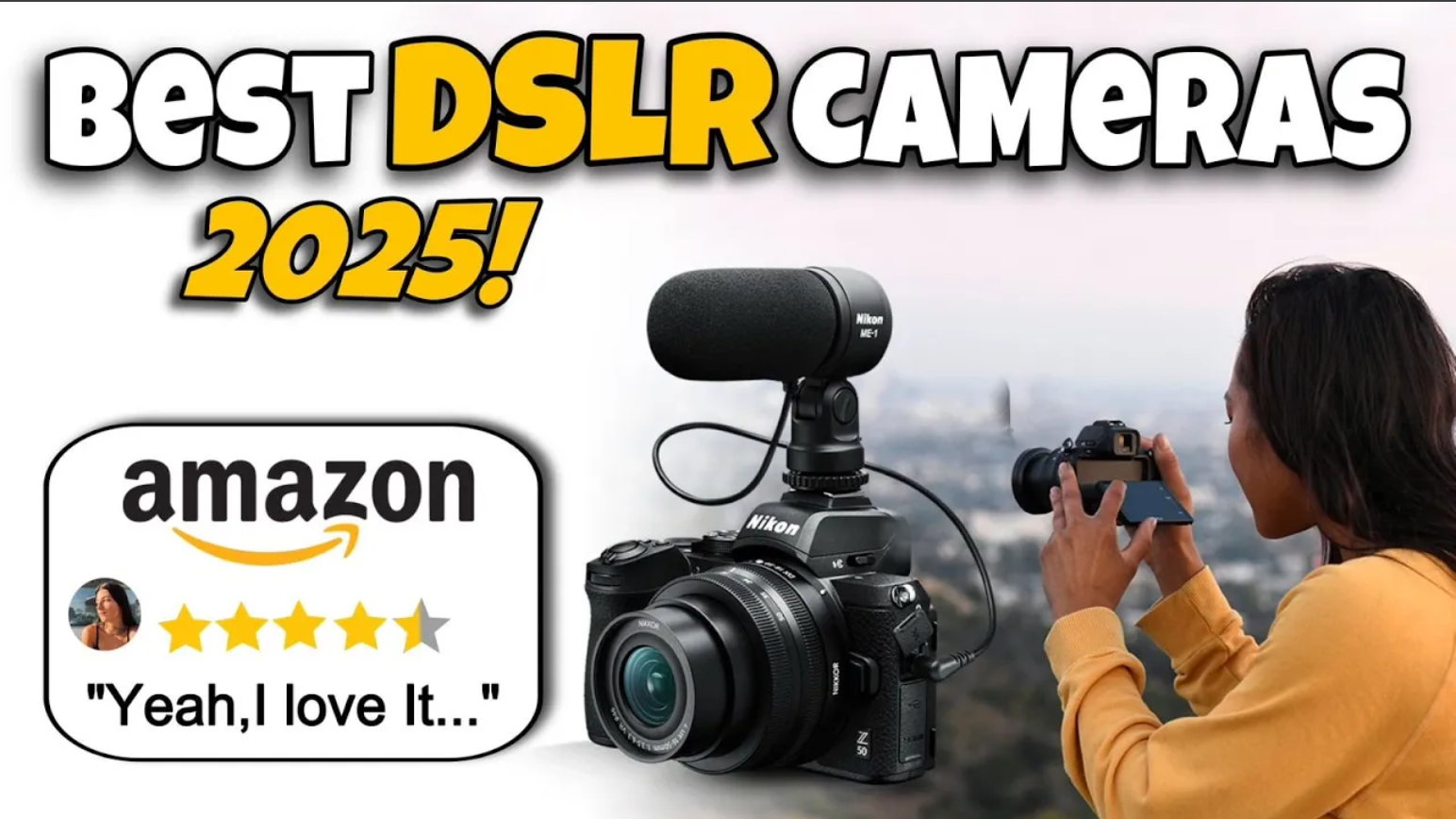Introduction to DSLR Photography
Digital Single-Lens Reflex (DSLR) cameras have long been a cornerstone in the world of photography, catering to both amateur enthusiasts and professional photographers alike. They combine digital imaging technology with the traditional mechanics of single-lens reflex cameras, enabling users to capture stunning images with remarkable clarity and precision. A key advantage of DSLR cameras is their ability to provide direct optical viewfinding through the lens, which helps in composing shots more accurately than other camera types, such as point-and-shoot or smartphone cameras.
One of the most significant characteristics of DSLRs is the extensive manual control over various settings, which allows photographers to adjust parameters such as aperture, shutter speed, and ISO sensitivity. This capability is crucial for achieving desired results in diverse lighting conditions and for creative effects. Whether capturing landscapes, portraits, or fast-paced action scenes, DSLRs offer the versatility and adaptability required to excel in various photographic situations.
Despite the competitive landscape introduced by mirrorless cameras and the omnipresence of smartphone technology, DSLRs have maintained their popularity and relevance in 2025. Many photographers appreciate the tactile feel and ergonomics of DSLRs, often citing the comfort of holding these robust cameras during prolonged shooting sessions. Additionally, the vast array of interchangeable lenses available for DSLR systems enables photographers to select the ideal lens for specific projects, thereby enhancing their creative possibilities.
Furthermore, DSLR cameras boast advanced autofocus systems, high-quality sensors, and impressive battery life, making them reliable tools for capturing memorable moments. As the photography community continues to evolve, DSLRs remain an enduring choice for many, blending tradition with cutting-edge digital technology to meet the demands of today’s visual storytellers.
Criteria for Selecting the Best DSLR Cameras
Choosing the right DSLR camera involves a careful evaluation of several essential factors. One of the most critical aspects is image quality, which largely depends on the camera’s sensor size. Larger sensors typically yield better image quality, especially in low-light conditions, and can capture more detail and a wider range of colors. The resolution, measured in megapixels, is also significant; however, it is vital to balance resolution with sensor size for optimal performance.
Another vital criterion to consider is autofocus performance. A reliable autofocus system, particularly one that has a fast and accurate focus, will greatly enhance the flexibility of a camera, especially for capturing moving subjects in various environments. Look for cameras featuring multiple autofocus points and advanced tracking capabilities to ensure sharp images in dynamic situations.
Build quality is another essential consideration, as it impacts the camera’s durability and usability in different environments. A well-constructed DSLR should be resistant to weather and wear while remaining comfortable to hold for extended periods. Ergonomic design can significantly enhance the user experience, allowing photographers to focus entirely on their creative expression.
Additionally, lens compatibility is crucial when selecting a DSLR. Different models accept various lenses, so understanding which lenses work with a chosen camera system is necessary for expanding photographic opportunities. Versatile lens options expand the creative possibilities, whether for portraits, landscapes, or macro photography.
Finally, user-friendliness cannot be overlooked. A camera that is intuitive to operate will encourage experimentation and learning. Furthermore, examining customer reviews and ratings on platforms like Amazon can provide valuable insight into real-world performance, helping guide your purchasing decision. By weighing these criteria, photographers can identify a DSLR camera that truly meets their specific needs.
Top Hot Picks:
- 24.1 Megapixel CMOS (APS-C) sensor with is 100–6400 (H: 12800)
- Built-in Wi-Fi and NFC technology
- 9-Point AF system and AI Servo AF
- An Always-Clear View, Even in Bright Sunlight: 2,360K-dot. Large LVF 0.74x (35mm camera equivalent) ensures you’ll see y…
- Amazing Video Quality for Fast-Paced Action: 4K Video Mode records up to 4x resolution of Full HD; for incredible flexib…
- Shoot Now, Focus Later: Post Focus feature gives you the power to touch the area you’d like to be in focus, even after t…
- Class leading image quality, ISO range, image processing and metering equivalent to the award winning D500
- Large 3.2” 922K dot, tilting LCD screen with touch functionality
- 51 point AF system with 15 cross type sensors and group area AF paired with up to 8 fps continuous shooting capability
- Advanced 24.2MP BSI Full-frame Image Sensor w/ 1.8X readout speed Advanced 24.2MP Back-Illuminated 35mm Full-frame Image…
- 15-stop dynamic range, 14-bit uncompressed RAW, ISO 50 to 204,800
- Up to 10fps Silent or Mechanical Shutter with AE/AF tracking
- Lightest, smallest full-frame EOS camera
- RF Mount Compatible with RF Lenses and EF/EF-S Lenses
- High Image Quality with 26.2 Megapixel Full-frame CMOS Sensor and DIGIC 8 Image Processor
- Compact, lightweight and durably constructed mirrorless camera
- First DX-format mirrorless camera to use a large 55 millimeter lens mount, offering advantages in high image quality and…
- 20.9 MP sensor with robust 4K UHD video features
- Photo and video capability 16 Megapixel micro Four Thirds sensor confidently captures sharp images with a high Dynamic R…
- 4K capture 4K Ultra HD video recording (3840 x 2160) Plus 4K PHOTO pause and save frame that extracts individual high-re…
- Intuitive controls easily control aperture and shutter speed settings with the front and rear dials while making white b…
- 4 K & 64 MP cameras for photography: Multiple video and photo sizes are up to you – video resolution:4 K /2.7 K /1080 P/…
- Doubles as A Webcam & Pause Function:Connect to PC and work as webcam to video calling. The camera have an excellent PAU…
- WiFi & HDMI Output Function: Saneen WiFi camera makes you can share the photos and videos online with mobile phones inst…

- Next Gen speed: experience the world’s fastest 0. 02 sec AF with real-time AF and object tracking
- Enhanced subject capture: wide 425 Phase/ 425 contrast detection points over 84% of the sensor
- Fast & accurate: up to 11Fps continuous shooting at 24. 2MP raw with crisp, clear natural colors
- 【4K Digital Camera with 180° Flip Screen】 Capture stunning 48MP photos and record smooth 4K videos at 30fps with the NBD…
- 【48MP Camera with Autofocus & 16x Zoom】 Achieve sharp, clear images with NBDDIGITAL’s autofocus and manual focus options…
- 【Vlogging Camera for YouTube with Fill Light】 Perfect for live streaming and video creation, this camera doubles as a hi…
More Detail On Our Youtube Video:
✅Top 10 Best DSLR Camera On Amazon 2025🔥 Perfect for Photography & Video!
Conclusion and Photography Tips
Choosing the right DSLR camera is a pivotal decision for both budding photographers and seasoned professionals. The DSLR cameras highlighted in the top 10 list on Amazon for 2025 not only provide exceptional image quality but also feature a variety of functionalities suitable for different photography genres. Investing in a reliable DSLR can significantly elevate your photography experience, allowing you to explore your artistic vision with clarity and precision.
To maximize the potential of your new camera, it is essential to master some fundamental photography concepts. One key aspect is lighting. Natural light can dramatically alter the mood of your photos, so understanding how to work with different light conditions can enhance your images significantly. Experimenting with the golden hour—shortly after sunrise or before sunset—can yield breathtaking results due to the softer and warmer tones during these times.
Another critical element is composition. Familiarizing yourself with techniques such as the rule of thirds, leading lines, and framing can help create visually compelling photographs. These principles guide the viewer’s eye and contribute to a balanced image. It is often worthwhile to step back and assess your surroundings to find unique perspectives that can enhance your composition further.
Lastly, basic editing techniques can elevate your photos to another level. Understanding how to adjust exposure, contrast, and color balance with editing software can fine-tune your images. Even simple adjustments can make a significant difference, transforming a good shot into a great one. Remember that editing is an extension of your creativity, so do not hesitate to experiment.
Armed with your new DSLR and these photography tips, you are now better equipped to capture stunning images. Explore your creativity and enjoy the journey it brings!
Note:-
As an Amazon Associate, I earn money from qualifying purchases. If you click links to various sellers in this website and make a purchase, this website may receive a commission.











